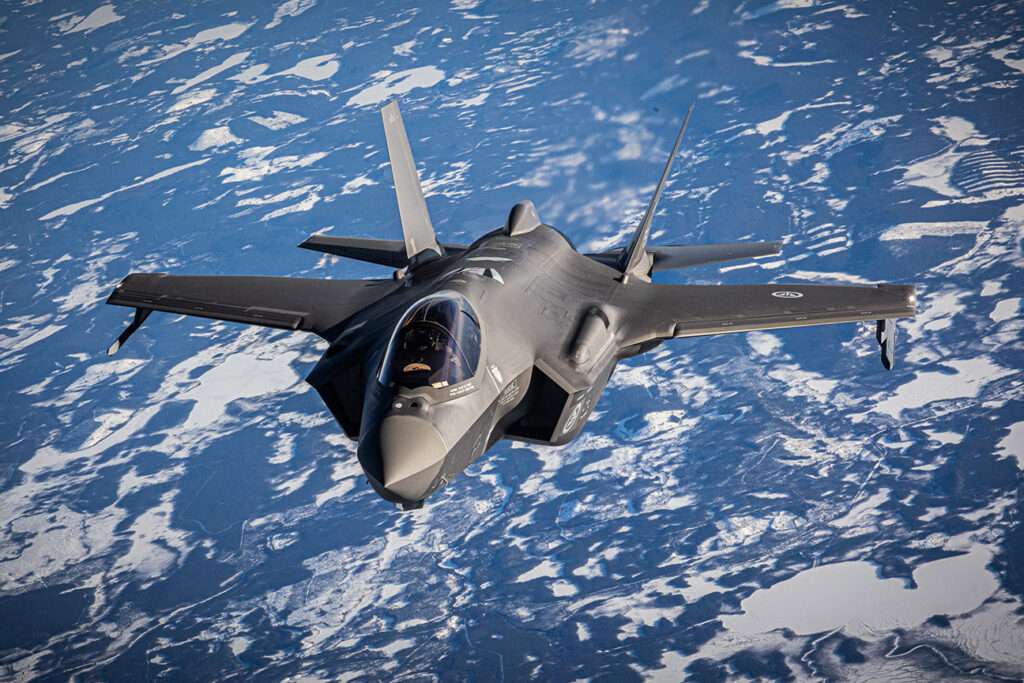A Norwegian F-35 Lightning II closes the gap to be refueled by a KC-135 Stratotanker assigned to the 101st Air Refueling Wing during Nordic Response 24 on March 11, 2024. MST. SGT. ANDREW SINCLAIR/U.S. AIR FORCE
THE WATCH STAFF
In “a huge milestone for Norway,” Lockheed Martin has delivered the final F-35A Lightning II aircraft to the Royal Norwegian Air Force, making the NATO ally the first F-35 partner nation to complete its scheduled procurement. “This is a big day, not only for the Air Force, but for the entire Armed Forces,” said Col. Ole Marius Tørrisplass, commander of 132 Air Wing at Ørland Main Air Station.
The final two F-35As, which arrived at Ørland in early April, fulfill the complement of 52 aircraft that Norway ordered, replacing the nation’s retired F-16s. Norway received its first two F-35s on November 3, 2017.
“The F-35 is the world’s best fighter jet, and I am very pleased that in April we have received the last of the 52 aircraft Norway has ordered from Lockheed Martin,” Minister of Defence Tore O. Sandvik said. “The aircraft ensure that we can assert Norwegian sovereignty and maintain even better control over our areas on land, at sea and in the air.”
The F-35 is a fifth-generation multirole fighter jet, incorporating major technological advances that make it the most formidable fighter in the air. Those advances include stealth technology, advanced electronics, maneuverability, and the ability to fly at supersonic speeds without using afterburners, enhancing its speed and range. The F-35A Lightning II can reach a top speed of Mach 1.6 or 1,642 kilometers per hour.
“The F-35 is a powerful tool for strategic deterrence, enhancing alliance-based security and discouraging potential aggression,” said Royal Norwegian Air Force Col. Egil Sørstrønen, the F-35 Joint Program Office Norway national deputy. “Receiving all our 52 F-35 aircraft thus represents a huge milestone for Norway. We highly value the solid and successful partnership with government and industry in the F-35 program, and we will continue to evolve Norway’s F-35 capability in strong cooperation with the other F-35 partner nations.”
Training and combat in the High North require an aircraft that can penetrate enemy airspace and get back home. F-35 stealth technology includes a low radar signature, which makes it difficult for enemy radar to acquire or target the jet. Its design uses aligned edges and continuous surfaces to minimize radar reflections. A coating used on the jets absorbs and reduces radar signals. Weapons and fuel are carried internally, also reducing the radar signature and increasing the craft’s speed and range.
In any future Arctic conflict, air dominance is paramount, and the F-35 Lightning II is designed to rule in air-to-air confrontations. The F-35’s radar, paired with its weapons, allows it to acquire enemies and engage beyond visual range to defeat them while staying undetected.
Special helmets that F-35 pilots wear are linked to the Electro-Optical Targeting System, which allows for precision targeting capability. The system also provides robust night vision. Forward-looking infrared with infrared search and tracking lets pilots fly at night without night vision goggles. In a region with long, dark winters, night flying capability is crucial in the High North. The F-35s will also display threat and friend signs to provide safeguards against friendly fire on land or at sea.
The F-35 Lightning II excels in air-to-ground combat. Its range exceeds 2,173 kilometers; with air-to-air refueling, its range is unlimited. It can carry a variety of weapons, and when deep strikes are needed, the Joint Air-to-Surface Standoff Missile (JASSAM) provides a highly accurate method to defeat high-value targets.
Containing enemy air defenses requires the ability to collect, prioritize, jam or attack enemy radar or missiles. Unlike its predecessors, the F-35 can play that role itself. Before the F-35, a separate aircraft was needed to carry out electronic warfare.
Not only can the F-35 collect electronic signals, it can retransmit them instantly to other aircraft, ground commanders, maritime forces and central command. Data can include the location of ground or sea threats, enemy radar sites, missile launches, and signals intelligence locating enemy command and control centers.
High North air operations have been a joint venture for years. Soon, Finland is expected to field its F-35s, and Belgium, Denmark, the Netherlands and Poland are in the process of fielding theirs. Nordic Air Forces, along with other NATO members, will work together to keep the High North safe.
In testimony before the Senate Armed Services Committee on February 13, 2025, Gen. Gregory M. Guillot, commander of U.S. Northern Command (USNORTHCOM) and the North American Aerospace Defense Command, said: “Arctic responsibilities are shared across multiple geographic and functional combatant commands, and as competition in the region increases, safeguarding Arctic access and freedom of maneuver will depend on Joint Force Arctic operational capabilities and build on the already strong ties between Arctic partners. USNORTHCOM places enormous value on the ability to conduct operations and exercises in the High North and to execute assigned missions in coordination with fellow combatant commands.”

